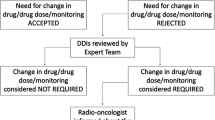Abstract
Background Cancer patients are especially vulnerable to drug interactions, which may alter the efficacy and toxicity of treatment, leading to severe clinical consequences. Objective Determine the incidence of such interactions in patients receiving chemotherapy, as well as to identify the drugs most frequently involved, investigate the influence of the pharmacist’s interventions and verify the degree of acceptance of pharmacist’s recommendations by the medical team. Setting The oncology department of a Spanish tertiary hospital. Methods During 3 months, all the drug interactions in the regular combined with treatment for cancer were analysed using two databases, and recommendations were made when clinically significant interactions (CSI) were identified. Main outcome measure Incidence of CSI in oncology outpatients; drugs involved in CSI. Results Of the 75 patients included, 31 (41 %) presented CSI. Most interactions were among drugs included in the patient’s usual treatment. The principal drug groups involved in CSI were cytostatic agents, antiemetics and antidepressants. The hospital pharmacist intervened on 20 occasions (35 % of the patients presenting drug interactions). These interventions mainly focused on recommendations to modify or discontinue drug prescriptions, and were followed in 94 % of cases. Conclusion The incidence of drug interactions in cancer patients is high, and they most often involve medications to treat comorbid conditions. The pharmacist, as a member of the multidisciplinary team, can contribute significantly by checking the treatment prescribed and detecting interactions, to reduce medication-related problems and to optimise drug therapy for these patients.
Similar content being viewed by others
References
Kotlinska-Lemieszek A, Paulsen O, Kaasa S, Klepstad P. Polypharmacy in patients with advanced cancer and pain. A European cross-sectional study of 2282 patients. J Pain Symptom Manage 2014. pii: S0885-3924(14)00223-1.
Chen L, Cheung WY. Potential drug interactions in patients with a history of cancer. Curr Oncol. 2014;21:212–20.
Lees J, Chan A. Polypharmacy in elderly patients with cancer: clinical implications and management. Lancet Oncol. 2011;12:1249–57.
Riechelmann RP, Saad ED. A systematic review on drug interactions in oncology. Cancer Invest. 2006;24:704–12.
Miranda V, Fede A, Nobuo M, Ayres V, Giglio A, Miranda M, et al. Adverse drug reactions and drug interactions as causes of hospital admission in oncology. J Pain Symptom Manage. 2011;42:342–53.
Riechelmann RP, Del Giglio A. Drug interactions in oncology: how common are they? Ann Oncol. 2009;20:1907–12.
Maggiore RH, Gross CP, Hurria A. Polypharmacy in older adults with cancer. Oncologist. 2010;15:507–22.
Tuna S, Dizdar O, Calis M. The prevalence of usage of herbal medicines among cancer patients. J BUON. 2013;18:1048–51.
McCune JS, Hatfield AJ, Blackburn AA, Leith PO, Livingston RB, Ellis GK. Potential of chemotherapy-herb interactions in adult cancer patients. Support Care Cancer. 2004;12:454–62.
Sokol KC, Knudsen JF, Li MM. Polypharmacy in older oncology patients and the need for an interdisciplinary approach to side-effect management. J Clin Pharm Ther. 2007;32:169–75.
Van Leeuwen RW, Swart EL, Boven E, Boom FA, Schuitenmaker MG, Hugtenburg JG. Potential drug interactions in cancer therapy: a prevalence study using an advanced screening method. Ann Oncol. 2011;22:2334–41.
Rodríguez-Terol A, Caraballo MO, Palma D, Santos-Ramos B, Molina T, Desongles T, et al. Calidad estructural de las bases de datos de interacciones. Farm Hosp. 2009;33:134–46.
Marion DW. Diaphragmatic pacing. In: UpToDate, Post TW (Ed), UpToDate, Waltham, MA. (Accessed on November 25, 2013). Available from: http://www.lexi.com.
Consejo General de Colegios Oficiales de Farmacéuticos (CGCOF). Base de Datos del Conocimiento farmacéutico BOT PLUS [CD-ROM]. Version 5.4.0; 2011.
Girre V, Arkoub H, Puts MTE, Vantelon C, Blanchard F, Droz JP, et al. Potential drug interactions in elderly cancer patients. Crit Rev Oncol Hematol. 2011;78:220–6.
Izzo A, Ernst E. Interactions between herbal medicines and prescribed drugs. Drugs. 2009;69:1777–98.
Using medication reconciliation to prevent errors. The Joint Commission. (Accessed on July 28, 2014). Available from: http://www.jointcommission.org/assets/1/18/SEA_35.PDF.
The Medicines Use Review (MUR) and Prescription Intervention Service. (Accessed on July 28, 2014). Available from: http://psnc.org.uk/wp-content/uploads/2013/06/MUR-service-spec-Aug-2013-changes_FINAL.pdf.
Wong CM, Ko Y, Chan A. Clinically significant drug-drug interactions between oral anticancer agents and nonanticancer agents: profiling and comparison of two drug compendia. Ann Pharmacother. 2008;42:1737–48.
Popa MA, Wallace KJ, Brunello A, Extermann M, Balducci L. Potential drug interactions and chemotoxicity in older patients with cancer receiving chemotherapy. J Geriatr Oncol. 2014;5:307–14.
Mancini R. Implementing a standardized pharmacist assessment and evaluating the role of a pharmacist in a multidisciplinary supportive oncology clinic. J Support Oncol. 2012;10:99–106.
Van Leeuwen RW, Brundel DH, Neef C, van Gelder T, Mathijssen RH, Burger DM, et al. Prevalence of potential drug-drug interactions in cancer patients treated with oral anticancer drugs. Br J Cancer. 2013;108:1071–8.
Hu Z, Yang X, Chi Lui Ho P, Yung Chan S, Wan Sia Heng P, Chan E, et al. Herb-drug interactions. A literature review. Drugs. 2005;65:1239–82.
Funding
None.
Conflicts of interest
The authors have no conflicts of interest to declare.
Author information
Authors and Affiliations
Corresponding author
Rights and permissions
About this article
Cite this article
Lopez-Martin, C., Garrido Siles, M., Alcaide-Garcia, J. et al. Role of clinical pharmacists to prevent drug interactions in cancer outpatients: a single-centre experience. Int J Clin Pharm 36, 1251–1259 (2014). https://doi.org/10.1007/s11096-014-0029-4
Received:
Accepted:
Published:
Issue Date:
DOI: https://doi.org/10.1007/s11096-014-0029-4



